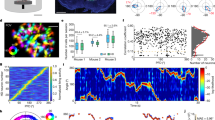Abstract
Continuous attractor networks require calibration. Computational models of the head direction (HD) system of the rat usually assume that the connections that maintain HD neuron activity are pre-wired and static. Ongoing activity in these models relies on precise continuous attractor dynamics. It is currently unknown how such connections could be so precisely wired, and how accurate calibration is maintained in the face of ongoing noise and perturbation. Our adaptive attractor model of the HD system that uses symmetric angular head velocity (AHV) cells as a training signal shows that the HD system can learn to support stable firing patterns from poorly-performing, unstable starting conditions. The proposed calibration mechanism suggests a requirement for symmetric AHV cells, the existence of which has previously been unexplained, and predicts that symmetric and asymmetric AHV cells should be distinctly different (in morphology, synaptic targets and/or methods of action on postsynaptic HD cells) due to their distinctly different functions.




Similar content being viewed by others
Notes
The authors wish to thank an anonymous reviewer for suggesting this interpretation of the calibration algorithm.
This experiment assumes that slow rotation of the visual environment induces a slow rotation of head direction representation. The alternative outcome, that the animal simply becomes disoriented, could possibly be avoided by using prominent visual cues and an extended training period, prior to testing, during which there is no cue rotation.
References
Baddeley, R. (1997). Responses of neurons in primary and inferior temporal visual cortices to natural scenes. Proceedings: Biological Sciences, 264(1389), 1775–1783.
Caporale, N., & Dan, Y. (2008). Spike timing-dependent plasticity: A hebbian learning rule. Annual Review of Neuroscience, 31, 25–46.
Cohen-Cory, S. (2002). The developing synapse: Construction and modulation of synaptic structures and circuits. Science, 298(5594), 770.
Dickson, B. J. (2002). Molecular mechanisms of axon guidance. Science, 298(5600), 1959–1964.
Engert, F., & Bonhoeffer, T. (1997). Synapse specificity of long-term potentiation breaks down at short distances. Nature, 388(6639), 279–284.
Feng, J., & Li, G. (2003). The relationship between neuronal calcium concentration and firing rate during stochastic synaptic inputs. Journal of Theoretical Biology, 223(3), 367–375.
Georgopoulos, A. P., Schwartz, A. B., et al. (1986). Neuronal population coding of movement direction. Science, 233(4771), 1416–1419.
Goodridge, J. P., & Touretzky, D. S. (2000). Modeling attractor deformation in the rodent head-direction system. Journal of Neurophysiology, 83(6), 3402–3410.
Hafting, T., Fyhn, M., et al. (2005). Microstructure of a spatial map in the entorhinal cortex. Nature, 436, 801–806.
Hahnloser, R. H. R. (2003). Emergence of neural integration in the head-direction system by visual supervision. Neuroscience, 120(3), 877–891.
O’Keefe, J., & Dostrovsky, J. (1971). The hippocampus as a spatial map. Preliminary evidence from unit activity in the freely-moving rat. Brain research, 34(1), 171.
Redish, A. D., Elga, A. N., et al. (1996). A coupled attractor model of the rodent head direction system. Network: Computation in Neural Systems, 7(4), 671–685.
Royer, S., & Pare, D. (2003). Conservation of total synaptic weight through balanced synaptic depression and potentiation. Nature, 422(6931), 518–522.
Scott, E. K., & Luo, L. (2001). How do dendrites take their shape? Nature Neuroscience, 4, 359–365.
Sharp, P. E., Blair, H. T., et al. (2001). The anatomical and computational basis of the rat head-direction cell signal. Trends in Neurosciences, 24(5), 289–294.
Skaggs, W. E., Knierim, J. J., et al. (1995). A model of the neural basis of the rat’s sense of direction. Advances in Neural Information Processing Systems, 7, 51–58.
Song, P., & Wang, X. J. (2005). Angular path integration by moving hill of activity: A spiking neuron model without recurrent excitation of the head-direction system. Journal of Neuroscience, 25(4), 1002–1014.
Stein, R. B. (1967). The frequency of nerve action potentials generated by applied currents. Proceedings of the Royal Society of London - Series B, Biological Sciences (1934–1990), 167(1006), 64–86.
Stringer, S. M., Trappenberg, T. P., et al. (2002). Self-organizing continuous attractor networks and path integration: One-dimensional models of head direction cells. Network: Computation in Neural Systems, 13(2), 217–242.
Suzuki, H., Thiele, T. R., et al. (2008). Functional asymmetry in Caenorhabditis elegans taste neurons and its computational role in chemotaxis. Nature, 454(7200), 114.
Taube, J. S. (2007). The head direction signal: Origins and sensory-motor integration. Annual Review of Neuroscience, 30, 181–207.
Taube, J. S., & Bassett, J. P. (2003). Persistent neural activity in head direction cells. Cerebral Cortex, 13(11), 1162–1172.
Taube, J. S., Muller, R. U., et al. (1990). Head-direction cells recorded from the postsubiculum in freely moving rats. I. Description and quantitative analysis. Journal of Neuroscience, 10(2), 420–435.
Turrigiano, G. G., & Nelson, S. B. (2004). Homeostatic plasticity in the developing nervous system. Nature Reviews Neuroscience, 5(2), 97–107.
Wang, X. J. (1999). Synaptic basis of cortical persistent activity: The importance of NMDA receptors to working memory. Journal of Neuroscience, 19(21), 9587–9603.
Xie, X., Hahnloser, R. H. R., et al. (2002). Double-ring network model of the head-direction system. Physical Review E, 66(4), 41902(1–9).
Zhang, K. (1996). Representation of spatial orientation by the intrinsic dynamics of the head-direction cell ensemble: A theory. Journal of Neuroscience, 16(6), 2112–2126.
Acknowledgements
The authors wish to thank two anonymous reviewers for suggestions which greatly improved the quality of this manuscript.
Author information
Authors and Affiliations
Corresponding author
Additional information
Action Editor: Barry Richmond
Rights and permissions
About this article
Cite this article
Stratton, P., Wyeth, G. & Wiles, J. Calibration of the head direction network: a role for symmetric angular head velocity cells. J Comput Neurosci 28, 527–538 (2010). https://doi.org/10.1007/s10827-010-0234-7
Received:
Revised:
Accepted:
Published:
Issue Date:
DOI: https://doi.org/10.1007/s10827-010-0234-7




